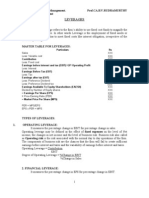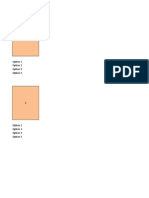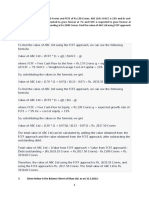0 ratings0% found this document useful (0 votes)
320 viewsBCG Approach
BCG Approach
Uploaded by
AdhityaBCG has defined two metrics for measuring shareholder value: TSR and TBR. TSR measures total shareholder returns based on dividends, share price changes, and cash flows to investors. TBR measures returns from the perspective of a business division based on free cash flow and equity value changes. BCG also advocates measuring corporate profitability using CFROI, which corrects for subjective accounting by assessing a firm's actual economic returns based on net operating profit and gross investment adjusted for depreciation and inflation. CFROI is preferred over EVA as it makes inflationary adjustments to assets and uses a consistent gross investment measure.
Copyright:
© All Rights Reserved
Available Formats
Download as DOCX, PDF, TXT or read online from Scribd
BCG Approach
BCG Approach
Uploaded by
Adhitya0 ratings0% found this document useful (0 votes)
320 views2 pagesBCG has defined two metrics for measuring shareholder value: TSR and TBR. TSR measures total shareholder returns based on dividends, share price changes, and cash flows to investors. TBR measures returns from the perspective of a business division based on free cash flow and equity value changes. BCG also advocates measuring corporate profitability using CFROI, which corrects for subjective accounting by assessing a firm's actual economic returns based on net operating profit and gross investment adjusted for depreciation and inflation. CFROI is preferred over EVA as it makes inflationary adjustments to assets and uses a consistent gross investment measure.
Original Description:
CFROI,EVA
Copyright
© © All Rights Reserved
Available Formats
DOCX, PDF, TXT or read online from Scribd
Share this document
Did you find this document useful?
Is this content inappropriate?
BCG has defined two metrics for measuring shareholder value: TSR and TBR. TSR measures total shareholder returns based on dividends, share price changes, and cash flows to investors. TBR measures returns from the perspective of a business division based on free cash flow and equity value changes. BCG also advocates measuring corporate profitability using CFROI, which corrects for subjective accounting by assessing a firm's actual economic returns based on net operating profit and gross investment adjusted for depreciation and inflation. CFROI is preferred over EVA as it makes inflationary adjustments to assets and uses a consistent gross investment measure.
Copyright:
© All Rights Reserved
Available Formats
Download as DOCX, PDF, TXT or read online from Scribd
Download as docx, pdf, or txt
0 ratings0% found this document useful (0 votes)
320 views2 pagesBCG Approach
BCG Approach
Uploaded by
AdhityaBCG has defined two metrics for measuring shareholder value: TSR and TBR. TSR measures total shareholder returns based on dividends, share price changes, and cash flows to investors. TBR measures returns from the perspective of a business division based on free cash flow and equity value changes. BCG also advocates measuring corporate profitability using CFROI, which corrects for subjective accounting by assessing a firm's actual economic returns based on net operating profit and gross investment adjusted for depreciation and inflation. CFROI is preferred over EVA as it makes inflationary adjustments to assets and uses a consistent gross investment measure.
Copyright:
© All Rights Reserved
Available Formats
Download as DOCX, PDF, TXT or read online from Scribd
Download as docx, pdf, or txt
You are on page 1of 2
BCG Approach
BCG has come up with an approach to shareholder value management and defined
two metrics namely
TSR and TBR
1. TSR- Total Shareholder Returns
TSR measures the full returns earned by shareholders from owning a
stock over a period of time. TSR can be calculated as follows:
TSR = Dividend per share +(Ending share price-Beginning share
price)/Beginning share price
TSR is Internal rate of return(IRR) of all cash flows paid to investors
during particular period
But this SHAREHOLDER VALUE APPROACH has come under increasing
scrutiny in recent years. It is argued that the approach encourage
managers to put interests of shareholders above those of other
stakeholders.
This approach makes the manager to focus on managing quarterly
earnings(Short term) at the expense of sustainable value(long term)
2. TBR Total Business Returns
While TSR measures the returns from companys shareholders
perspective, TBR measures the returns from business divisional or
Strategic Business Unit(SBU) perspective. TBR is calculated as follows
TBR = (Free Cash flow)/(Beginning equity value) + (Ending equity
value Beginning Equity value)/Beginning equity value
TBR is internal equivalent of TSR
3. CFROI
Corporate financial statements can be misleading. Companies typically
employ subjective accounting methods such as depreciation and offbalance sheet items which misrepresent the true profitability of the
firm.
The HOLT methodology corrects the subjectivity by converting income
statement and balance sheet into a CFROI return, a measure that
closely look into companys underlying economics.
CFROI is proxy for companys economic return. CFROI is calculated as
follows:
CFROI = (Gross Cash flow- Economic Depreciation)/Gross Investment
Gross cash flow is (NOPAT+ Accounting Depreciation)
Gross Investment is (Net asset value + Accumulated Depreciation +
Current dollar adjustment)
CFROI for a firm is IRR on existing investments based upon real cash
flows. CFROI should be compared to real cost of capital to make
judgments about the quality of investments
4. CFROI versus EVA
CFROI is a % measure while EVA is absolute dollar value
CFROI makes inflationary adjustments on the assets but EVA does not.
EVA uses Net fixed assets which is not a consistent measure. When the
new assets are employed, depreciation amount for those assets will be
higher, resulting in less EVA value and as on when the assets become
older, correspondingly EVA will become higher.
But CFROI uses Gross Investment which makes inflationary
adjustments.
References
1. https://www.bcg.com/documents/file90853.pdf
2. http://people.stern.nyu.edu/adamodar/pdfiles/valn2ed/ch32.pdf
3. Strategic Financial Management textbook by Prasanna
Chandra
You might also like
- Capital StructureDocument7 pagesCapital StructureKhushi RaniNo ratings yet
- Report of Internship Hedge PDFDocument56 pagesReport of Internship Hedge PDFGopi Krishnan.n100% (1)
- Capital Budgeting: Payback PeriodDocument4 pagesCapital Budgeting: Payback PeriodPooja SunkiNo ratings yet
- Revenue (Sales) XXX (-) Variable Costs XXXDocument10 pagesRevenue (Sales) XXX (-) Variable Costs XXXNageshwar SinghNo ratings yet
- Qualifying Exam Review Qs Final Answers2Document30 pagesQualifying Exam Review Qs Final Answers2JCGonzales100% (1)
- Balance Sheet and Ratio Analysis of A BankDocument52 pagesBalance Sheet and Ratio Analysis of A BankArchanaHegdeNo ratings yet
- Downloadable Test Bank For Business Ethics A Stakeholder and Issues Management Approach 5tTB Ch02 1Document7 pagesDownloadable Test Bank For Business Ethics A Stakeholder and Issues Management Approach 5tTB Ch02 1ridha azka rNo ratings yet
- DCF ValuationDocument3 pagesDCF ValuationDurga ShankarNo ratings yet
- Assignment Financial ManagementDocument5 pagesAssignment Financial Managementhoneyverma30100% (1)
- 11 Chapter 5.2 - Capital StructureDocument15 pages11 Chapter 5.2 - Capital Structureatishayjjj123No ratings yet
- FM RTP Merge FileDocument311 pagesFM RTP Merge FileAritra BanerjeeNo ratings yet
- Chapter 6 - Using Discounted Cash Flow Analysis To Make Investment DecisionsDocument14 pagesChapter 6 - Using Discounted Cash Flow Analysis To Make Investment DecisionsSheena Rhei Del RosarioNo ratings yet
- Value Based Management BCG ApproachDocument14 pagesValue Based Management BCG ApproachAvi AhujaNo ratings yet
- FINANCIAL MANAGEMENT Assignment 2Document14 pagesFINANCIAL MANAGEMENT Assignment 2dangerous saifNo ratings yet
- Capital Budgeting SHARIBDocument103 pagesCapital Budgeting SHARIBfarzijii4No ratings yet
- Financial Management CIA-1.2Document9 pagesFinancial Management CIA-1.2arnav chandnaNo ratings yet
- FM - Dividend Policy and Dividend Decision Models (Cir 18.3.2020)Document129 pagesFM - Dividend Policy and Dividend Decision Models (Cir 18.3.2020)Rohit PanpatilNo ratings yet
- Corp Finance Group One Course Work (Final)Document27 pagesCorp Finance Group One Course Work (Final)jonas sserumagaNo ratings yet
- Investment Appraisal Techniques 2Document24 pagesInvestment Appraisal Techniques 2Jul 480wesh100% (1)
- Capital Structure ProblemsDocument6 pagesCapital Structure Problemschandel08No ratings yet
- Kota Tutoring: Financing The ExpansionDocument7 pagesKota Tutoring: Financing The ExpansionAmanNo ratings yet
- Assignment Questions - Corporate Financial RestructuringDocument3 pagesAssignment Questions - Corporate Financial RestructuringPranjali Aananda MoreNo ratings yet
- Concept and Classification of BetaDocument16 pagesConcept and Classification of BetamonuNo ratings yet
- TVM Practice Sums & SolutionsDocument15 pagesTVM Practice Sums & SolutionsRashi Mehta100% (1)
- Costing System at Plastim CorporationDocument10 pagesCosting System at Plastim CorporationKumar SunnyNo ratings yet
- Working CapitalDocument7 pagesWorking CapitalSreenath SreeNo ratings yet
- Overview of Financial ManagementDocument16 pagesOverview of Financial ManagementKAUSHIKNo ratings yet
- Leverages NotesDocument9 pagesLeverages NotesAshwani ChouhanNo ratings yet
- Balance of Payments:: Chapter Objectives & Lecture Notes FINA 5500Document27 pagesBalance of Payments:: Chapter Objectives & Lecture Notes FINA 5500Anonymous H0SJWZE8100% (1)
- Dividend Discount ModelDocument48 pagesDividend Discount ModelRajes DubeyNo ratings yet
- CFi Capital Structure Leverage ProblemsDocument6 pagesCFi Capital Structure Leverage ProblemsJustin Russo HarryNo ratings yet
- Ebit Eps AnalysisDocument22 pagesEbit Eps AnalysisPiyuksha PargalNo ratings yet
- EBIT EPS AnalysisDocument17 pagesEBIT EPS AnalysisAditya GuptaNo ratings yet
- Corporate Finance - Question Bank 2Document10 pagesCorporate Finance - Question Bank 2Ganesh GaneshNo ratings yet
- 2.2-Module 2 Only QuestionsDocument46 pages2.2-Module 2 Only QuestionsHetviNo ratings yet
- Unit 2 Capital StructureDocument27 pagesUnit 2 Capital StructureNeha RastogiNo ratings yet
- Ch.7.Corporate Valuation - Explanations and SolutionsDocument67 pagesCh.7.Corporate Valuation - Explanations and SolutionsabhiNo ratings yet
- Final Doc of Management AssignmentDocument10 pagesFinal Doc of Management AssignmentrasithapradeepNo ratings yet
- Complex GroupsDocument12 pagesComplex GroupsRaquibul HasanNo ratings yet
- Appendix - 8A The Maturity ModelDocument10 pagesAppendix - 8A The Maturity ModelAndreea IoanaNo ratings yet
- FM RTP, MTP, S.Answer Final FileDocument142 pagesFM RTP, MTP, S.Answer Final Filedeepu deepuNo ratings yet
- Cost of CapitalDocument16 pagesCost of CapitalParth BindalNo ratings yet
- FCFF and FCFE QuestionsDocument4 pagesFCFF and FCFE Questionsaks171No ratings yet
- Operating Cycle of Business and Financing Working - CapitalDocument23 pagesOperating Cycle of Business and Financing Working - CapitalKarthik SuryanarayananNo ratings yet
- Capital Budgeting AnswerDocument18 pagesCapital Budgeting AnswerPiyush ChughNo ratings yet
- CH 14Document17 pagesCH 14rameshmbaNo ratings yet
- Chapter 13 PDFDocument73 pagesChapter 13 PDFMUKESH KUMARNo ratings yet
- Chapter (4) : Fund Flow Statements: Saoud Chayed MashkourDocument18 pagesChapter (4) : Fund Flow Statements: Saoud Chayed MashkourParamesh Miracle100% (1)
- Risk Analysis in Capital BudgetingDocument70 pagesRisk Analysis in Capital BudgetingdhavalshahicNo ratings yet
- Questions 2023Document6 pagesQuestions 2023Rajesh YadavNo ratings yet
- Chapter - 8: Capital Budgeting DecisionsDocument44 pagesChapter - 8: Capital Budgeting DecisionsAmisha SinghNo ratings yet
- Financial Performance Analysis of HDFC Using Dupont AnalysisDocument7 pagesFinancial Performance Analysis of HDFC Using Dupont AnalysisMohmmedKhayyumNo ratings yet
- Practice Questions On Time Value of MoneyDocument7 pagesPractice Questions On Time Value of MoneyShashank shekhar ShuklaNo ratings yet
- IFM Module 6 ProblemsDocument7 pagesIFM Module 6 ProblemsAlissa BarnesNo ratings yet
- LeverageDocument36 pagesLeveragereddyhareeNo ratings yet
- Class Notes Capital Rationing Sir Saud Tariq ST AcademyDocument13 pagesClass Notes Capital Rationing Sir Saud Tariq ST AcademyAhmed NisarNo ratings yet
- DDM PPTDocument20 pagesDDM PPTAnubha SinghalNo ratings yet
- MCO 07 EM 2024 @ignouallqueries1Document10 pagesMCO 07 EM 2024 @ignouallqueries1surbhi_sharma_2613No ratings yet
- Managing Bank CapitalDocument24 pagesManaging Bank CapitalHenry So E DiarkoNo ratings yet
- 5.valuation of BusinessDocument6 pages5.valuation of BusinessHalf-God Half-ManNo ratings yet
- Dividend PolicyDocument13 pagesDividend PolicyRakesh Gupta100% (2)
- Funds Flow AnalysisDocument16 pagesFunds Flow AnalysisGyan PrakashNo ratings yet
- Important Theory Questions of Financial ManagementDocument24 pagesImportant Theory Questions of Financial Management50. Harini .SNo ratings yet
- Cost Of Capital A Complete Guide - 2020 EditionFrom EverandCost Of Capital A Complete Guide - 2020 EditionRating: 4 out of 5 stars4/5 (1)
- Visi Dan Misi Kementerian Keuangan:: ANTAM's Vision 2030Document5 pagesVisi Dan Misi Kementerian Keuangan:: ANTAM's Vision 2030Willy DavidNo ratings yet
- This Study Resource Was: Asian Academy For Excellence Foundation, IncDocument5 pagesThis Study Resource Was: Asian Academy For Excellence Foundation, IncAnne Marieline BuenaventuraNo ratings yet
- Unit 5 Dividend Policy Refers To The Set of Guidelines and Decisions That A CompanyDocument9 pagesUnit 5 Dividend Policy Refers To The Set of Guidelines and Decisions That A Companykhageswarsingh865No ratings yet
- Gold Company Provided The Following Trial Balance On June 30 PDFDocument3 pagesGold Company Provided The Following Trial Balance On June 30 PDFRengeline LucasNo ratings yet
- Aro Granite ReportDocument7 pagesAro Granite ReportsiddharthgrgNo ratings yet
- Partnership and CorporationDocument3 pagesPartnership and Corporationgianfranco0613No ratings yet
- Structure of Stock ExchangeDocument12 pagesStructure of Stock ExchangeSaurabh KhandaskarNo ratings yet
- Buyback of Shares of HulDocument7 pagesBuyback of Shares of HulBoota DeolNo ratings yet
- Form AR01 Annual ReturnDocument14 pagesForm AR01 Annual Returnaglondon100No ratings yet
- Demat Account Advantages and Disadvantages PDFDocument1 pageDemat Account Advantages and Disadvantages PDFAdity NachreNo ratings yet
- (Wilmerding, 2001) Term Sheets & Valuations PDFDocument131 pages(Wilmerding, 2001) Term Sheets & Valuations PDFЕвгений ИстоминNo ratings yet
- AKL 2 - Tugas 3 Marselinus A H T (A31113316)Document3 pagesAKL 2 - Tugas 3 Marselinus A H T (A31113316)Marselinus Aditya Hartanto TjungadiNo ratings yet
- Lifting of Corporate VielDocument5 pagesLifting of Corporate VielRyan TapiseniNo ratings yet
- Cargill To Buy Cotton Ginning Business in Southern AfricaDocument2 pagesCargill To Buy Cotton Ginning Business in Southern AfricaelcheokNo ratings yet
- Mergers & Acquisitions: Chapter-1Document47 pagesMergers & Acquisitions: Chapter-1dharmbir kumarNo ratings yet
- Jurnal JurnalDocument82 pagesJurnal JurnalAde Maria UlfaNo ratings yet
- Rare Earth MetalsDocument6 pagesRare Earth MetalsJames Ugo100% (1)
- PR - Order in The Matter of Equinox Infratech LimitedDocument1 pagePR - Order in The Matter of Equinox Infratech LimitedShyam SunderNo ratings yet
- Personal Life: Vijay Mallya (Document9 pagesPersonal Life: Vijay Mallya (Rohit PendalwarNo ratings yet
- TDM-Annual Report 2019Document288 pagesTDM-Annual Report 2019ir_yusriNo ratings yet
- Financial Results For The Three Months Ended July 31, 2022Document9 pagesFinancial Results For The Three Months Ended July 31, 2022Ally LuNo ratings yet
- Stockholders Right To InspectDocument3 pagesStockholders Right To InspectVolt LozadaNo ratings yet
- Leverage and Its TypesDocument5 pagesLeverage and Its TypessarkctNo ratings yet
- STOXX 600 Index - Dividends and Implied Volatility Surfaces ParametersDocument5 pagesSTOXX 600 Index - Dividends and Implied Volatility Surfaces ParametersQ.M.S Advisors LLCNo ratings yet
- TheoriesDocument6 pagesTheoriesFhremond ApoleNo ratings yet
























































































